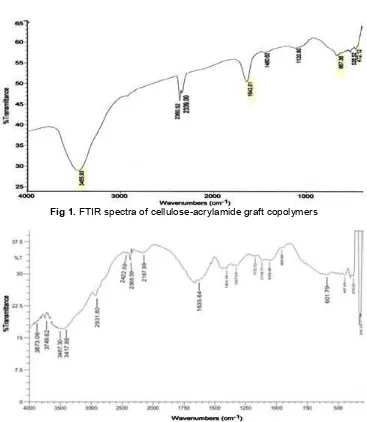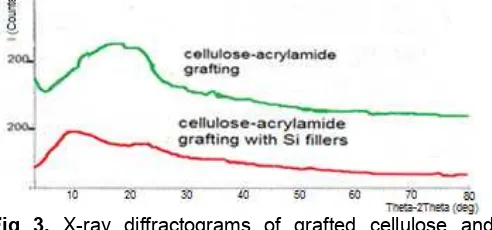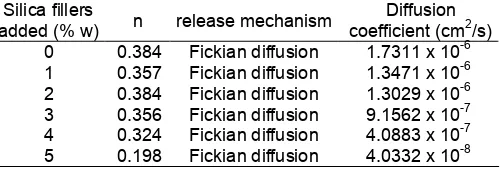EFFECT OF SILICA FILLERS ON CHARACTERIZATION OF CELLULOSE-ACRYLAMIDE
HYDROGELS MATRICES AS CONTROLLED RELEASE AGENTS FOR UREA FERTILIZERS
Deni Swantomo
1,2,*, Rochmadi
2, Kris Tri Basuki
1, and Rahman Sudiyo
2 1Polytechnic Institute of Nuclear Technology, National Nuclear Energy Agency, Jl. Babarsari Kotak Pos 6101 YKBB Yogyakarta 55281 Indonesia
2
Chemical Engineering Department, Universitas Gadjah Mada, Jl. Grafika No 2, Bulaksumur Yogyakarta 55281 Indonesia
Received March 6, 2014; Accepted May 7, 2014
ABSTRACT
Controlled Release Urea Fertilizers-based hydrogels matrices was synthesized by graft copolymerization of acrylamide onto the rice straw cellulose backbones in the presence of silica fillers using simultaneous graft copolymerization by gamma irradiation as initiator. Evidence of the silica presence on grafted cellulose was obtained from FTIR. X-ray diffraction analysis showed that the crystalline was reduced through silica fillers added. The effect of silica content on grafting efficiency, gel fraction, Young modulus, swelling degree, and urea loading were examined. It was found that grafting efficiency and gel fraction decrease with increasing silica added inversely with Young modulus. Water swelling and loading urea fertilizers into hydrogels matrices were conducted and the results showed that swelling degree and urea fertilizers loading increased first and then decreased with increasing silica added. The effect of the silica fillers had implications in the mechanism of controlled release urea fertilizers that diffusion-controlled mechanism became dominant, which attributed to the decreasing of urea diffusion coefficient.
Keywords:silica fillers; hydrogels; gamma irradiation; controlled release urea fertilizers
ABSTRAK
Pupuk urea lepas terkendali berbasis matriks hidrogel telah dibuat dengan proses kopolimer grafting akrilamida dengan selulosa dari jerami padi dan penambahan filler silika yang menggunakan metode kopolimerisasi grafting simultan dengan iradiasi Gamma sebagai inisiator. Adanya filler silika yang terikat pada hasil grafting selulosa diperoleh dari hasil FTIR. Analisis X-ray difraksi menunjukkan kristalinitas hidrogel berkurang dengan ditambahkannya filler silika. Pengaruh jumlah silika terhadap efisiensi grafting, fraksi gel, modulus Young, derajat swelling dan pemuatan pupuk urea juga dipelajari. Hasil penelitian menunjukkan bahwa efisiensi grafting dan fraksi gel berkurang dengan meningkatnya jumlah silika yang ditambahkan serta berbanding terbalik terhadap nilai modulus Young. Proses swelling di dalam air dan pemuatan pupuk urea ke dalam matriks hidrogel telah dilakukan dan diperoleh hasil bahwa derajat swelling dan jumlah pemuatan pupuk urea akan meningkat kemudian menurun dengan peningkatan jumlah silika yang ditambahkan. Penambahan filler silika sangat mempengaruhi mekanisme pelepasan pupuk urea yang lebih mengarah mekanisme yang dikendalikan proses difusi, hal ini juga dapat menurunkan nilai koefisien difusi urea.
Kata Kunci:filler silika; hidrogel; irradiasi gamma; pupuk urea lepas terkendali
INTRODUCTION
Urea is a low cost solid nitrogen (N) fertilizer. However, the N uptake by crops from urea is often as low as 30-50%, with an environment cost associated to N losses via NH3 volatilization, NO3
-leaching and N2O
emission. In agriculture, loss of nutrient elements is one of large problems. The methods for overcoming these shortcoming involves the use of Slow Release Fertilizers (SRF) and Controlled Release Fertilizers (CRF), which has demonstrated many advantages over the
in the swollen state [3-5]. The higher production cost and low gel strength of these hydrogels restrict their application widely. To improve these limitations, low cost inorganic compounds can be used. The introduction of inorganic fillers such carbon, clays and silica to a polymer matrix increases its strength and stiffness properties [9-13]. Among inorganic compounds, special attention has been paid to silica in the field of CRF because of their small particle size, hydrophilic and amorf properties. Silica fillers usually act as covalently bound and multifunctional cross-linkers to the polymer, which leads to mechanical toughness, high tensile modules, and rapid swelling. An important feature for obtaining an improvement in the properties (in particular mechanical) is a strong interface adhesion between filler and the polymer matrix. This can be achieved through the grafting of a polymerizable group onto the oxide surface (via hydroxyl groups) followed by its copolymerization with organic monomers, a process that is expected to result in the formation of organic– inorganic hybrids [7,14].
The fillers added can influence the swelling hydrogels, reduce the burst effect, increase stability and provide enhanced barrier properties for solute and provide a slower release [7,10]. In present study, effect of silica fillers on synthesis smart hydrogels based cellulose-acrylamide grafting as CRF using simultaneous gamma irradiation technique were studied. The effects of silica fillers content on hydrogels characterization such grafting efficiency, gel fraction, swelling degree in water also mechanical properties were reported.
EXPERIMENTAL SECTION
Materials
Rice straw and rice husk ash were obtained from rice field in Bantul, Indonesia. Acrylamide monomer pure analysis grade was obtained from MERCK product. Sodium hydroxide, acetone, aquades, ethanol, H2SO4
were technical grade.
Instrumentation
Volumetric glasses were used for preparing reagent, acrylamide, cellulose and silica. Gamma Chamber-40 was used for irradiation sample. Hydrogels were analyzed using Thermo Nicolet Avatar FTIR spectrophotometer and X-ray diffractometer Shimadzu type 6000.
irradiation
Cellulose from rice straw was mixed with distilled water at 400 rpm at room temperature for 1 h. Acrylamide added into the mixture for 8 h. The mixtures were added by silica fillers from rice husk ash in various composition i.e. 0, 1, 2, 3, 4, and 5% weight then irradiated under gamma radiation using Gamma Chamber-40 Grafting efficiency determined using gravimetric then calculated using Eq. 1:
h s
where Wh is weight of cellulose-acrylamide graft
copolymer, Wsis weight of cellulose, and Wmis weight
of acrylamide monomer.
Characterization of cellulose-acrylamide graft copolymerization hydrogels
FTIR study of cellulose-acrylamide graft copolymers was done using Thermo Nicolet Avatar FTIR spectrophotometer. X-ray diffraction studies used X-ray diffractometer XRD (Shimadzu type 6000). Crystallinity percentage (%Cr) and crystallinity index (C.I.) [15] were calculated according to Eq. 2 and 3:
22
where, I22 and I18 are the crystalline and amorphous intensities at 2θ scale close to 22° and 18°,
respectively. The gel fraction was then calculated using Eq. 4:
where, W0is the initial weight of the sample, and W1 is
weight of the insoluble residue. The swelling degree is calculated as shown in Eq. 5:
ss d
where, Wss is the weight of hydrogels in swollen state
and Wdis the weight of hydrogels in dry state. Young’s
modulus of hydrogels were tested according to ASTM D638 using Universal tensile testing machine.
Fig 1.FTIR spectra of cellulose-acrylamide graft copolymers
Fig 2.FTIR spectra of cellulose-acrylamide graft copolymers with silica added
RESULT AND DISCUSSION
Characterization of Cellulose-Acrylamide Graft Copolymers Silica Filler Added using FTIR and X-ray Diffraction
One way to evaluate the successful silica fillers added onto grafting of cellulose-acrylamide is by comparing the functionality of the grafted cellulose with that of grafted cellulose with fillers added. For this purpose, grafted cellulose and grafted cellulose with fillers added were characterized using FTIR spectroscopic technique which the results are presented in Fig. 1 and 2. The most obvious characteristic of the grafted cellulose with silica added spectra which distinguished it from the spectra of the grafted cellulose is the presence of absorption bands at 894 cm-1, which is ascribed to the Si–OH stretching [8,11]. The spectra of
grafted cellulose with silica added show broader band at 3417–3487 cm-1 for the N-H stretching overlapping with the OH-stretching from silica, 1150–1130 cm-1 for Si-O-Si bending which implies the formation of silica clusters in the pores of grafted cellulose, a medium peak at 600–810 cm-1for Si-OH. The bands are slightly shifted in the presence of silica as was also explained by Huang et al. [11]. The FTIR spectra data indicate that the silica fillers were incorporated in the cellulose hydrogels successfully.
Fig 3. X-ray diffractograms of grafted cellulose and grafted cellulose with silica added
Table 1. Crystallinity percentage and crystallinity index of grafted cellulose and grafted cellulose with silica added
Type Cellulose crystallinity percentage (%)
crystallinity index Grafted cellulose 82.05 0.7812 Grafted cellulose
with silica added 79.25 0.7381
Table 2.Effect of silica added on grafting efficiency, gel fraction and Young modulus
Silica fillers
0 98.04 89.61 78.98
1 83.43 98.80 82.62
2 77.93 98.60 85.05
3 76.45 96.65 87.91
4 75.34 92.62 93.64
5 69.49 89.31 96.81
to the breakdown of hydrogen in the crystalline part of cellulose chains. Crystallinity index gives a quantitative measure of the orientation of the cellulose crystals in the fibers [15]. A lower crystalline index in case of silica fillers added means poor order of arrangement of cellulose crystals in the fiber, which is due to disorientation of the cellulose crystalline lattice to the fiber axis during silica added.
Effect of Silica Fillers Added on Grafting Efficiency, Gel Fraction and Young Modulus
The grafting efficiency, gel fraction and Young modulus were investigated with different silica fillers added ranging from 0 to 5% w as shown in Table 2. It can be seen that the incorporation of silica fillers reduces cellulose grafting efficiency. Numerous functional and chemical active groups on the surface of silica fillers are responsible for bond formation between silica and grafted cellulose chain. Meanwhile, it seems that silica consumes available radical sites and also by introducing spatial obstacles, reduces the miscibility, consequently reduces the extent of grafting. The additives like
matrix, this may hinder radical–radical interactions and reduce grafting. Studied by Dubey et al. [16] have shown that rate of radiation induced graft copolymerization decreases in presence of inorganic fillers though the kinetics remains unchanged.
Gel fraction of grafted cellulose without any silica fillers was 89.61%. It is increased to 98.80% by addition of silica fillers. Increases in insoluble gel content with silica fillers added are due to the formation of a network structure, bound polymer layer and increase in the polymer-fillers interaction [8]. By fillers added, crystallinity grafted polymers decreases as shown in XRD studies (Fig. 3 and Table 1) and the amount of side chains increases therefore the permeation of water molecules into polymer structure and gel fraction increases. However, gel fraction value decreased with increasing in silica content but still higher than unfilled grafted cellulose. Further increase of silica content increasing the viscosity of grafting medium will be increased and restricted macro radicals movement; thereby decreasing gel content. Similar trends were observed and reported by other researchers [11,17]. As the content of silica increased, phase separation occurred that resulted in loosen gel structure and consequently reduce gel fraction.
Table 2 shows that the Young modulus of the grafted cellulose hydrogels increases with increasing silica fillers content where this shows the clear indication of the ability of silica from rice husk ash to impart greater stiffness to the grafted cellulose. It is known that filler, which has a higher stiffness than the matrix can increase the modulus of composites but generally it is reciprocal to elongation at break [12-13]. As fillers content increased, the possibility of filler-matrix interaction increased which increase efficiency of stress transfer from matrix to filler phase. Thus, increasing silica content which having higher stiffness than grafted cellulose matrix hydrogels will eventually increases the modulus of elasticity. Similar improvements in Young modulus were also reported by previous researchers in their work on any clay fillers [13-17]. The primary cause for such improvement was attributed to better interaction of polymer chains with fillers and large number of interacting molecules due to dispersed phase volume ratio.
Effect of Silica Fillers Added on Swelling Hydrogels and Loading of Urea Fertilizers
Table 3. Effect of silica added on swelling degree and
Table 4 Effect of silica filler on diffusion coefficient and release mechanism
Silica fillers
added (% w) n release mechanism
Diffusion coefficient (cm2/s) 0 0.384 Fickian diffusion 1.7311 x 10-6 1 0.357 Fickian diffusion 1.3471 x 10-6 2 0.384 Fickian diffusion 1.3029 x 10-6 3 0.356 Fickian diffusion 9.1562 x 10-7 4 0.324 Fickian diffusion 4.0883 x 10-7 5 0.198 Fickian diffusion 4.0332 x 10-8
content is shown in Table 3. It was shown that silica fillers, at low concentrations (1-3%), significantly increased the swelling i.e. 660-2149% and urea fertilizers loading i.e. 0.22-3.38 g/g. Silica from rice husk ash are strongly hydrophilic materials with many hydroxyl groups (-OH). As confirmed by the FTIR spectra increasing amount of -OH on the grafted cellulose with silica added should be responsible for the hydrophilic improvement. It was established that the hydrophilic fillers favored the swelling because fillers of hydrophilic surface provide further space in the polymer matrix for water molecules [3-4,7]. Swelling measurements revealed that the change in entropy of the swelling increased with the increase in disorder network [1,12]. The result of XRD analysis showed that crystallinity percentage of grafted cellulose with silica added was decreasing which means increasing amorphous and disordered network which enhances the urea fertilizers loading during swelling. However, increasing the silica fillers amount to more than 3% does not further improve swelling degree and urea loading. Huang et al. [11] and Hosseinzadeh [7] also reported the similar results. At higher filler contents, even up to 3 wt%, the disorderedness tend to decrease and the equilibrium between disorder phase and intercalated phase drawn towards intercalation to result in reduced swelling and urea loading.
Effect of Silica Fillers Added on Release of Urea from CRF
The mechanism of release from CRF hydrogels was investigated using Korsmeyer-Peppas model [1,5]:
n
where Mt and M∞ represent the amount of urea
released at a time t and at equilibrium, respectively, k is the constant characteristic of fertilizer-polymer system, and n is the diffusion exponent characteristic of the release mechanism. When n is equal or less than 0.5, the diffusion mechanism is Fickian, it is case II when n is equal to 1, and for values of n between 0.5 and 1, the mechanism is non Fickian. The values of diffusion constants and diffusion exponents are listed in Table 4.
The n value was observed to decrease with increasing silica content i.e. 0.384 to 0.198 (i.e., towards to diffusion-controlled mechanism), suggesting that silica fillers plays a more significant role in diffusion than swelling rate. This is due to the fact that well-dispersed silica fillers act as a diffusion barrier, causing a significant decrease in the diffusion coefficient of urea fertilizers. Moreover, strong filler-urea fertilizers interaction and high cross-link extent (tight intermolecular structure) also probably lowered the mobility of urea diffusing through grafted hydrogels matrices [14]. Therefore, the diffusion-controlled mechanism became dominant in this condition. Decreasing diffusion of urea fertilizers into the network hydrogels in this case is associated with the effective linkages (due to crosslinking and/or entanglements) and also filling of voids within the network hydrogels with silica filler. In other words, increase in the filler concentration enhances the network strength and decreases the free volume distributed within the cross-linkages, thus resulting in the reduction of solute diffusion into the hydrogels network. Silica fillers in the hydrogels matrices can keep the loaded urea fertilizers in their interphase with composite structure. This means that silica fillers within matrix and surface of hydrogels can act as reservoirs for the urea fertilizers loaded. Some other researchers have also reported same phenomenon [4-5,7,10]. Xiang and Chen [9] showed that Ag nanoparticles within the PHPM hydrogels act as nano-sized reservoirs that can change the diffusion characteristics of molecules through the nanocomposite hydrogels.
CONCLUSION
from the silica filled hydrogels were Fickian diffusion. The diffusion coefficient of urea release from loaded hydrogels decrease with increasing silica added.
ACKNOWLEDGEMENT
The authors are grateful for the financial support of LPDP Ministry of Finance Republic Indonesia and The State Ministry of Research and Technology for Doctoral scholarship program.
REFERENCES
1. Hekmat, A., Barati, A., Frahani, E.V., and Afraz, A., 2009,World Acad. Sci. Eng. Technol., 56, 96–100. 2. Shavit, U., Reiss, M., and Shaviv, A., 2003, J.
Controlled Release, 88 (1), 71–83.
3. Bignotti, F., Lebon, F., and Peroni, I., 2007, Eur. Polym. J., 43 (5), 1996–2006.
4. Córdoba, A.L., Deladino, L., and Martino, M., 2013, Carbohydr Polym., 95 (1), 315–323.
5. Liu, T.Y., Chen, S.Y., Chen, S.C., and Liu, D.M., 2006, J. Nanosci. Nanotechnol., 6 (9-10), 2929–2935.
8. Hardinnawirda, K., and Aisha, S.R., 2012,J. Mech. Eng. Sci., 2, 181–186.
9. Xiang, Y., and Chen, D., 2007, Eur. Polym. J., 43 (10), 4178–4187.
10. Salgueiro, A.M., Daniel-da-Silva, A.L., Fateixa, S., and Trindade, T., 2013,Carbohydr. Polym., 91 (1), 100–109.
11. Huang, W.J., Tsai, H.H., and Lee, W.F., 2010, Polym. Compos., 31 (10), 1712–1721.
12. Acharya, H., and Srivastava, S.K., 2006, Macromol. Res., 14 (2), 132–139.
13. Jamal, N.A., Anuar, H., and Razak, S.B.A., 2011, Can. J. Sci. Ind. Res., 2 (3), 95–101.
14. Dubey, K.A., Chaudhari, C.V., Rao, R., Bhardwaj, Y.K., Goel, N.K., and Sabharwal, S., 2010,J. Appl. Polym. Sci., 118 (6), 3490–3498.
15. Nada, M.A., El-Kady, M.Y., El-Sayed, S.Y., and Amine, F.M., 2009, BioResources, 4 (4), 1359–1371.
16. Dubey, K.A., Bhardwaj, Y.K., Chaudhari, C.V., Kumar, V., Goel, N.K., and Sabharwal, S., 2009, eXPRESS Polym. Lett., 3 (8), 492–500.


